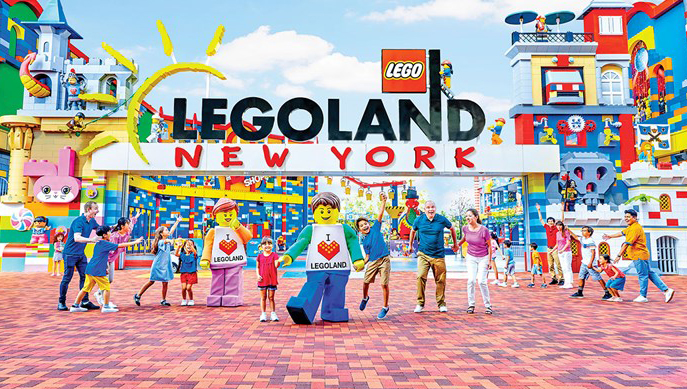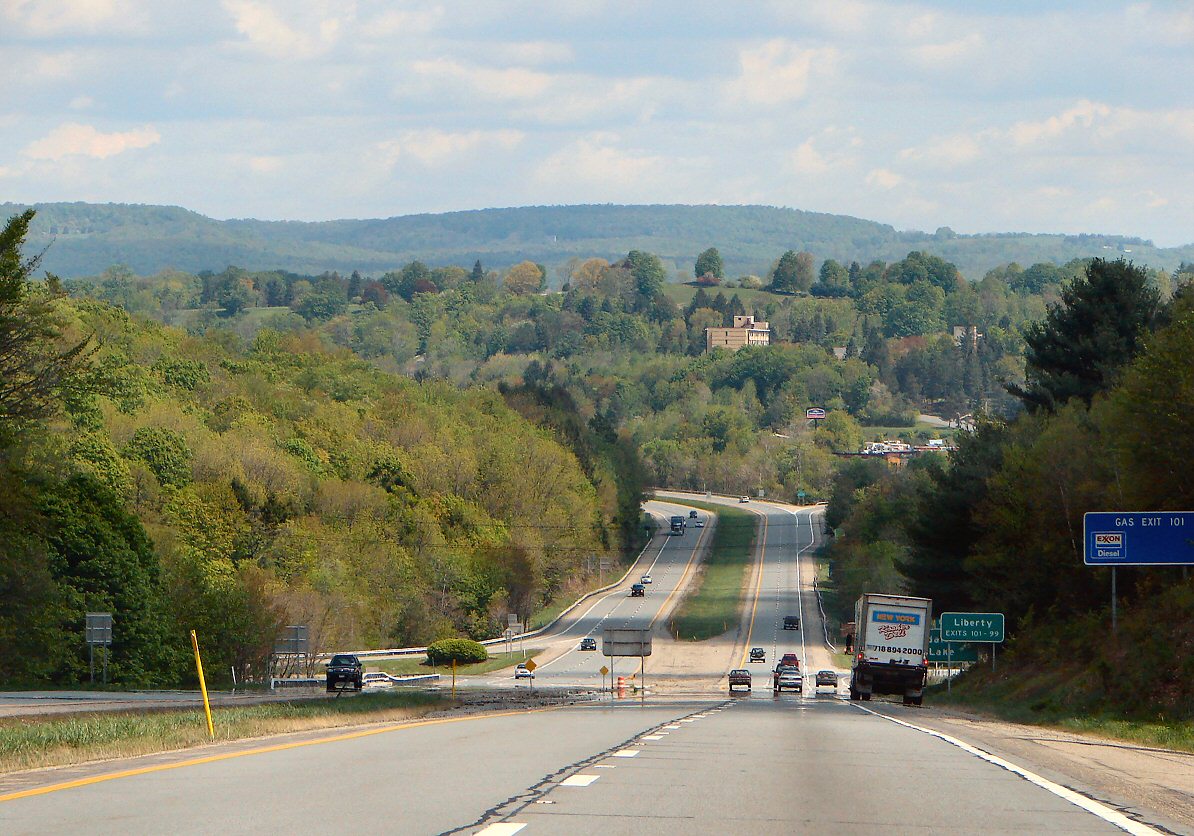Fresh from self proclaiming himself a Transit Guy, and saving the MTA, Sen. Chuck Schumer has now returned his attention to a upstate highway boondoggle that even many locals say is will only choke the Catskills in congestion and sprawl.
Schumer has championed an unnecessary plan to widen New York’s Route 17 — the main artery of the Catskills, in the Hudson Valley about 70 miles northwest of New York City — for more than 15 years, and he’s looking to get it over the hump now that Democrats control Congress.
The $500-million road widening would add a third lane in each direction along a 45-mile stretch of the four-lane highway, from the Exit 131 Harriman interchange to Exit 103 in Monticello, with the goal of making it more like an interstate. The plan is being pushed by 17-Forward-86, a coalition of real-estate, business and construction interests formed last year to support the road widening.
The group says that a more-voluminous highway will stimulate the local economy, and that the widening would produce 500 temporary construction jobs and 1,000 indirect jobs — which, at $500 million, means taxpayers are subsidizing those jobs at more than $333,000 apiece. As its name suggests, it sees the 45-mile widening as part of a larger push to make Route 17 part of Interstate 86, as it is called in the western part of the state, where the road is slowly being brought up to interstate highway standards. The coalition has sought to give impetus to the widening in recent weeks by touting it as a natural part of Democrats’ plans to shower federal cash on infrastructure.
Dave Church, now retired from his job as planning commissioner of Orange County, wrote a memo for the county two years ago arguing that the Route 17 widening is too expensive given other, competing local infrastructure/transit needs, and that the lack of dedicated funding for the project in the state budget makes it a dicey proposition. The federal government often pays for highway construction costs, only to leave states holding the bag for expensive repairs and maintenance; the average new-lane mile costs $24,000 a year to keep in good repair, and from 2008 to 2018 the highway debt of state transportation agencies more than doubled.
Plus, the project violates the state's own principals. Highway widening, also known as capacity building, is low to no priority in New York State given established policy that system "'preservation’ is most important in the view of constricted funding,” Church said. Many local travelers hop on and off the highway after two or three exits; investment in public transit and local road improvement to make alternative travel easier and safer could help relieve congestion on the roadway.
Enter Schumer, who is interceding with U.S. Department of Transportation Secretary Pete Buttigieg in hopes of prioritizing the project.
“I've been pushing for years to widen Route 17 to three lanes, from Orange to Sullivan," Schumer told the Hudson Valley Economic Development Corp. last month. "If we get this big infrastructure bill...I'm going to push very hard, as one of my very highest priorities in the country, to get the widening." (Funny how Schumer doesn't make such comments when he Zooms into community board hearings in New York City.)
Asked for further comment in light of growing objections to the widening, Schumer spokeswoman Allison Biasotti touted the senator's record on transit. “Sen. Schumer has long and effectively delivered for mass transit and road improvements throughout the state, including $8 billion to resuscitate New York transit and is working now to deliver $7 billion more to mass transit throughout New York,” she said.
But does such an expanded road constitute the kind of smart growth that New Yorkers would expect their liberal senator to support?
No.
"We measure the wrong things in transportation, which often leads us in the wrong direction,” Beth Osborne, director of Transportation for America, told Streetsblog. “The question is not whether a project will speed vehicle travel along a corridor. The question should be whether the project connects people (particularly underserved people) to more jobs and essential services without cutting others off."
Others, especially some former local transportation and planning officials, think the project is a mistake — and not only because of the well-known phenomenon of “induced demand,” in which wider roads only attract more traffic congestion in a self-defeating spiral. Adding lanes never works to relieve congestion; rather, it only encourages people to drive more and real-estate interests to build more far-flung homes and facilities — thus adding to congestion and sprawl.

Robert Dennison, a former chief engineer for the New York State DOT and former regional director of its Hudson Valley region, told Streetsblog that the traffic volumes on Route 17, which peak on Friday evening when people travel to the Catskills and again on Sunday evening when they leave, do not justify the proposed road widening.
"Why waste the money on this ‘superhighway’ ... when you really have needs in the cities of the state?” Dennison asked, pointing to the decrepit Brooklyn-Queens Expressway as one road in dire need of an expensive redo. The Route 17 widening amounts to “an expensive project that feeds car culture” and won’t stimulate the economy of the Catskills, as proponents hope. People are not avoiding the Catskills because of traffic congestion, Dennison said.
Route 17, moreover, which threads through some pretty steep terrain, is an unlikely candidate to become a freeway across the southern tier of New York State, as the 17-Forward-86 hopes. Dubbed the “quick way” in the middle of the 20th century, Route 17 is almost 400 miles long, connecting 11 counties; federal legislation designated it as a future interstate in 1998, and it was supposed to be completed as such in 2009. In Sullivan and part of Orange counties, however, the existing improved highway was cobbled together from a number of rinky dink local roads. As it crosses the Catskills, Route 17 has beautiful views, but suffers from steep grades. So it does not meet interstate standards, and it would be prohibitively expensive to make the improvements for converting it into an interstate.
Still, local electeds, such as State Sen. James Skoufis (D-Hudson Valley) — and a raft of local Republican leaders, such as Orange County Executive Steve Neuhaus — have been pushing the project, backed by the vociferous lobbying of 17-Forward-86. By 2019, the group had spent at least $174,483 advocating for the widening, according to its tax forms, arguing that a bigger road is necessary for the local economy, which is powered by tourism.
“I just don’t understand how our elected Republican leaders are lining up behind Schumer to support spending $500 million of taxpayer money for a few hundred jobs, on a project that will not achieve its intended objectives. That is not fiscal responsibility. That is a misuse of funds,” said Arif Khan, an urban planner and adviser to Catskill Mountainkeeper, an environmental group that opposes the widening.
Skoufis and other widening proponents point to the burgeoning of local attractions in the Catskills. In recent years, Sullivan County has gained a casino, Resorts World, in Monticello; the kiddie park Legoland, in Goshen; and an indoor water park, the Kartrite Resort, also in Monticello — all of which draw cars, cars and more cars. (Woodbury Common, a popular outlet mall in Monroe, recently benefited from $150 million in state highway improvements around Exit 131.)
“Anyone who suggests there isn’t a capacity issue likely hasn’t spent an iota of time on Route 17 during summer weekends when, without fail every weekend, there are hours of bumper-to-bumper congestion,” insisted Skoufis’s press aide Jessica Gulotta [point of information: it is not hours]. “We invite you to visit in a few months, especially after Legoland opens and thousands of additional vehicles are on the highway, to see for yourself and tell the senator's constituents with a straight face that the project isn’t needed.” She added that “every single municipal board along the proposal’s route supports the project.”
Sen. Schumer today told the Hudson Valley Economic Development Corp. that widening Route 17 to three lanes in Orange and Sullivan counties is the “very highest priority” in pending federal infrastructure legislation. Watch the video here: pic.twitter.com/OgpItbN39v
— 17Forward86 (@17Forward86) February 5, 2021
Catskill Mountainkeeper offers that very straight-faced analysis. The group’s senior project manager on the proposed Route 17 widening, Sam Wright, points to a 2013 NYSDOT study that found that a third lane on the road was unnecessary for most of the proposed area of the widening. He argued that the lane would induce more traffic, more congestion, longer delays at bottlenecks, and millions of tons of CO2 emissions.
“Numerous state laws and regional planning documents support our position that the project will contribute to sprawl and will not address transportation equity,” he said. “It is a waste of good money that will only make the problems it seeks to solve worse.”
For now, the Route 17 widening is in the planning stage: A planning and environmental linkage study is expected to be completed in October, when public outreach would commence. Schumer’s office did not respond to a message seeking comment, nor did the press office of Gov. Cuomo, which has been busy with other topics.






